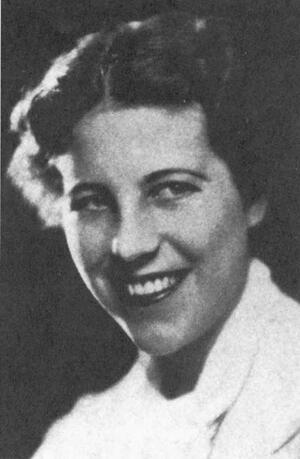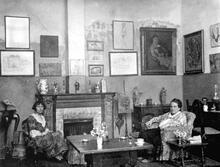Tess Slesinger
An unconventional childhood and her association with Jewish left-wing literary radicals shaped the biting satire of Tess Slesinger's novels and short stories. Her subsequent conquest of Hollywood as a screenwriter was cut short by her untimely death at age thirty-nine.
Institution: The Jacob Rader Marcus Center of the American Jewish Archives, Cincinnati, OH, www.americanjewisharchives.org
With a skill for balancing emotion and satire, Tess Slesinger became a successful novelist and screenwriter. After studying journalism at Columbia University, Slesinger married Herbert Solow and began writing book reviews for his left-wing Menorah Journal. Following their divorce, Slesinger published her 1934 novel The Unpossessed. In 1935, she published a collection of short stories, Time: The Present and, later that year, she was hired as a Hollywood screenwriter. While working on a screenplay for Pearl Buck’s The Good Earth, Slesinger met her second husband Frank Davis; together, they wrote several more screenplays. Slesinger died of cancer at age thirty-nine and did not live to see the premiere of her final collaboration with Davis, film adaption of A Tree Grows in Brooklyn.
Dedicating her 1934 novel The Unpossessed “to my contemporaries” and titling her 1935 collection of stories Time: The Present may have been eerily prescient of Tess Slesinger. Not only did her fiction embrace the cross-currents of the lived moment, but her life was cut short by cancer. As a parodic historian of her own times, Slesinger wrote fiction that combined jazzy, up-to-the-minute reports on the state of marriage, sexuality, political culture, and work in 1930s America with a biting, yet emotionally revealing style typical of Vanity Fair and the New Yorker where she published frequently. Her brief life spanned the continent from the heady world of New York left-wing intellectuals to Hollywood’s sunshine as a screenwriter.
Early Life and Family
Born on July 16, 1905, to well-to-do Hungarian-Russian Jewish parents, Slesinger grew up with three older brothers on New York’s Upper West Side. Educated at the Ethical Culture Society School, Swarthmore College, and the Columbia School of Journalism, where in 1925 she received a B.A. in English, Slesinger moved quickly from the sheltered world of wealthy, assimilated Jews into the internecine warfare of New York’s Left after her 1928 marriage to classmate Herbert Solow. After working as a journalist for a few years, Slesinger began writing book reviews for the Menorah Journal, a left-wing cultural magazine founded and edited by Solow and Columbia professor Elliot Cohen. This world of radicalized, educated Jews offered Slesinger the material she satirized in The Unpossessed, published two years after her divorce from Solow.
Slesinger’s early childhood was atypical for her class, ethnicity, and era; both her mother and father worked outside the home. Anthony Slesinger had dropped out of law school to help run his father-in-law’s garment business, while Augusta (Singer) Slesinger worked in social service agencies, eventually becoming executive secretary of the Jewish Big Sisters. Augusta Slesinger was one of the founders of the New School for Social Research, where she trained as a lay analyst with Erich Fromm and Karen Horney in the mid-1930s. The awareness of psychological ambivalence and her parents’ unconventional relationship contributed to Tess Slesinger’s pointed irony about her husband’s group of radical Jewish humanists. It certainly shaped her vision of marriage and work and the vexed battle between the sexes that was the subject of much of her fiction and screenwriting.
Fiction, Screenplays, and Politics
Slesinger began publishing early, but her first big success came in 1932, the year she and Solow divorced, when Story published “Missis Flinders,” an arch and wicked yet moving tale of a young wife’s decision to have an abortion in order to keep her activist husband “free.” The notoriety this quasi-autobiographical story received convinced Slesinger to expand the piece into a complex novel tracing not only the Flinderses’ disintegrating marriage but the ravaged lives of a group of left-wing writers and artists gathered around a charismatic Jewish professor to start a magazine. Critics immediately praised Slesinger’s novel, calling it “impeccable,” “brilliantly written,” and “sheer genius,” and began sorting out the characters of this roman à clef convinced that, in Murray Kempton’s words, The Unpossessed was a “document” about 1930s literary radicals. However, though the novel and the story collection published the next year were based on Slesinger’s experiences, the portraits of the many characters who swirl in and out of universities, society galas, street demonstrations, offices, and abortion clinics describe and set into context a wide variety of that quintessential 1930s type: “the people.”
On the strength of her acclaimed fiction, in mid-1935 Irving Thalberg offered Slesinger a salary of a thousand dollars a week as a Hollywood screenwriter. Her first major assignment was to cowrite the screen adaptation of Pearl S. Buck’s The Good Earth. On the set, she met her second husband, assistant producer Frank Davis. They married in Mexico in 1936. The two collaborated on scripts, eventually cowriting or adapting four films during the 1940s, including the original screenplay for Dorothy Arzner’s feminist musical comedy Dance, Girl, Dance and the screen adaptation of Betty Smith’s working-class novel A Tree Grows in Brooklyn. Like her fiction, Slesinger’s screenplays dealt with class differences, sexual competition, gender inequality, and the problems of the artist in contemporary society.
A Short Life
After leaving the New York circle of left-wing anti-Stalinists, Slesinger, unlike many men in the anti-Stalinist Left, did not move right. Instead, after Germany invaded the Soviet Union and the United States entered World War II, she forged strong connections to the Communist Party through the Anti-Nazi League, the League of American Writers, and the Screen Writers’ Guild, of which she was a committed member upon her arrival in Hollywood. Slesinger did not live to see the premiere of A Tree Grows in Brooklyn; on February 21, 1945, she died of cancer at age thirty-nine, leaving two children, Peter, born in January 1937, and Jane, born in March 1938. Peter Davis continues his family’s commitment to politics and film, directing powerful documentaries such as the antiwar film Hearts and Minds.
Selected Works by Tess Slesinger
Fiction
“After the Cure.” Vanity Fair 43 (1935): 48, 65–66.
“Ben Grader Makes a Call.” Vanity Fair 42 (1934): 40, 70.
“The Best Things in Life Are Three.” Vanity Fair 44 (1935): 16, 52b.
“Brother to the Happy.” Pagany 3 (1932): 77–82,
“For Better, for Worse.” Delineator 28 (1936): 18–19.
“A Hollywood Gallery.” Michigan Quarterly Review 18 (1979): 439–454.
“Kleine Frau.” Modern Youth 1 (1933): 28–32.
“The Lonelier Eve.” New Yorker 10 (28 April 1934): 32–33.
“Mr. Palmer’s Party.” New Yorker 11 (27 April 1935): 30–32.
“The Old Lady Counts Her Injuries.” Vanity Fair 43 (1934): 23, 79.
Time: The Present (1935). Reprinted with the addition of “A Life in the Day of a Writer,” from Story (November 1935) as On Being Told That Her Second Husband Has Taken His First Lover and Other Stories (1971).
The Unpossessed (1934); “You Gi-i-ive Yourself or Drop the Handkerchief.” Vanity Fair 44 (1935): 41, 60b.
"White on Black." The American Mercury, vol. 21, No. 84 (December 1930): 470-476.
“Young Wife.” This Quarter 3 (1931): 698–708.
Nonfiction
“How to Throw a Cocktail Party.” Vanity Fair 44 (1935): 46–47, 59.
“Memoirs of an Ex-Flapper.” Vanity Fair 43 (1934): 26–27, 74, 76.
“Where the Dear and the Antelope Roam …” Vanity Fair 44 (1935): 42–43.
“Writers on the Volcano.” Clipper: A Western Review 2 (1941): 4–6.
Screenplays
Are Husbands Necessary? with Frank Davis. Paramount (1941).
The Bride Wore Red, with F. Bradbury Foote. MGM (1937).
Dance, Girl, Dance, with Frank Davis. RKO (1940).
Girl’s School, with Richard Sherman. Columbia (1938).
The Good Earth, with Talbot Jennings and Claudine West. MGM (1937).
His Brother’s Wife. MGM (1936).
Remember the Day, with Frank Davis and Allan Scott. Twentieth Century–Fox (1941).
A Tree Grows in Brooklyn, with Frank Davis, additions by Anita Loos. Twentieth Century–Fox (1945).
Biagi, Shirley. “Forgive Me for Dying.” Antioch Review 35 (1977): 224–236.
Jewish American Women Writers: A Bio-Bibliographical and Critical Sourcebook. Edited by Ann R. Shapiro (1994).
Kempton, Murray. Part of Our Time (1955).
Rabinowitz, Paula. Labor and Desire: Women’s Revolutionary Fiction in Depression America (1991).
Sharistanian, Janet. “Afterword.” The Unpossessed (1984), and “Tess Slesinger’s Hollywood Sketches.” Michigan Quarterly Review 18 (1979): 439–454.
Teres, Harvey. Renewing the Left: Politics, Imagination, and the New York Intellectuals (1996).
Trilling, Lionel. “Young in the Thirties.” Commentary 41 (1966): 43–51. Reprinted as “Afterword.” The Unpossessed (1966).
Wald, Alan. The New York Intellectuals (1987).
WWIAJ (1938).





